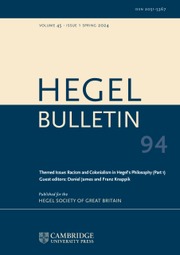No CrossRef data available.
Article contents
How to Make Content out of Form: Towards a Hegelian-Saussurean Theory of Non-Linear Structures of Possibility
Published online by Cambridge University Press: 16 May 2019
Abstract
In this article I argue that Hegel and Saussure both discovered a new mode of theorization that I propose to call ‘structural explication’. This is distinct from the generally dominant ‘linear’ mode of theorization—i.e., causal and quasi-causal explanations. I also argue that the standard criticisms usually directed against Hegel and Saussure stem from a failure to appreciate the nature of structural explication. For example, both Hegel and Saussure argue that—in some deep sense—form can generate content. But this must be comprehended in a strictly non-linear way. A linear interpretation of such arguments will lead to absurdities. I propose to call such deep generative structures (with a nod to Kant) the ‘necessary structures of possibility’. By comparing Hegel's thoughts on the science of a philosophical logic and Saussure's thoughts on the science of a general linguistics it is possible to discern a deep ‘scientific’ affinity. Furthermore, I argue that the structural level cannot be accounted for in any linear way. On the contrary, the linear explanation is fundamentally dependent on a structural explication of the genesis of the basic terms it assumes as ‘given’. A possible reason for the pervasiveness of the linear explanation (besides, perhaps, the success of causality-oriented natural sciences) is that discursive language is linear and our lived experience in time is linear. Thus, a structural explication will inherently appear less intuitive, and maybe also less ‘satisfying’, than a linear explanation. Finally, I also bring the distinction between the linear and the structural to bear on Robert Brandom's normative pragmatist reading of Hegel's ‘semantic holism’.
Information
- Type
- Research Article
- Information
- Copyright
- Copyright © The Hegel Society of Great Britain 2019


